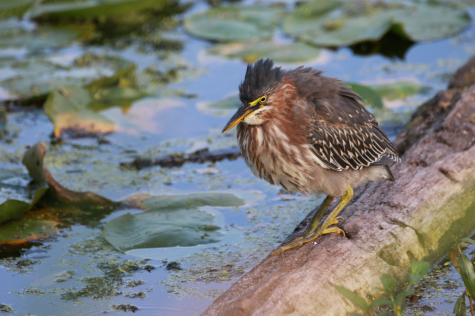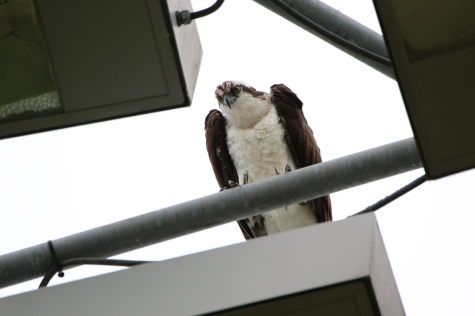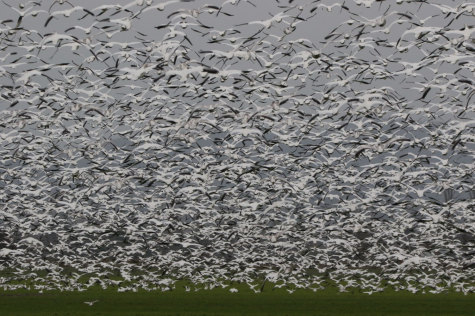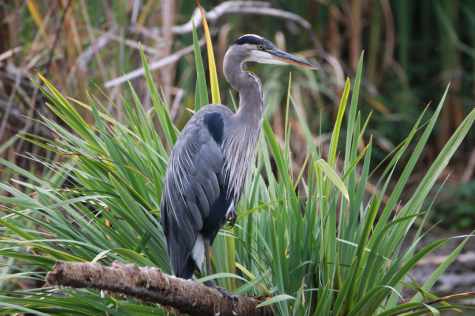A Short, Subjective Guide to Washington Birding
In my humble opinion, I think birds are kinda neat.
Genuinely, I can’t espouse the virtues of birding enough. If you haven’t even tried going to a park and looking at a duck or perhaps a goose, then I’d recommend you drop what you’re doing now, go outside, and stare at some crows.
But where, you might ask, do I go outside to see birds? My answer would involve gesturing vaguely around me, because birds are everywhere in Washington State. Everywhere! You just have to look for them.
Regardless, I will concede that maybe some people’s idea of birding involves going out to a park or another dedicated space. And now that I’m off to the other side of the country, where I’ll have to learn this all over again, I might as well leave some of my knowledge (and that of Mr. Searl and Mr. de Grys, as they are superior to me in every way) while I shuffle out the front door.
Juanita Bay

A juvenile green heron at Juanita Bay, shortly after a successful fishing session.
I’ll let you in on a little secret: I’m a Kirkland baby.
Well, more accurately, I lived in Kirkland to attend two years of elementary school, before moving to Bellevue. Regardless, Juanita Bay is a gem, a cozy harbor-turned-natural-area just south of a popular beach. It specializes in accessible coast and marsh, with wooden trails running through the intermediate wetland all the way out to platforms by the shore. The area is rich with all kinds of aquatic birdlife: red-winged blackbirds, coots, all kinds of ducks, and double-crested cormorants. There are bald eagles year-round, ospreys in summer, kingfishers, swans in the winter, and the inland areas have local woodpeckers, sparrows, and wrens.
The platforms can also bring the birds much closer — blackbirds sometimes perch within feet of you, and herons hunt unconcerned. In fact, Juanita Bay Park is the first place I took decent photos of the elusive green heron. That day I spent almost three hours rooted in one spot, but a visit can be as short as thirty minutes.
Marymoor Park

An osprey by its nest next to Marymoor Park.
Continuing with the theme of eastside birding, Marymoor might seem like a bit of an odd pick: it’s an off-leash dog park. Yet all the same, Marymoor never disappoints.
First, Marymoor Park is the king of biome variety: fields, forests, wetland, river, lake — it’s got it all. Even though many of the fields are almost always inhabited by roaming dogs, it’s still prime habitat for swallows. The forests get their fair share of woodpeckers, sparrows, wrens, and robins, wetlands are prime habitat for blackbirds and ducks, and the river feeding into Lake Sammamish is a great spot for eagles, kingfishers, ospreys, ducks, herons, and waders. My record for eagles observed in one tree belongs to Marymoor, at a happy twelve.
Finally, Marymoor is the go-to spot for herons, thanks to the infamous great blue heron cottonwood roost. It’s impossible to ignore, with dozens of herons and their babies constantly calling and begging from spring to early summer, all along a popular trail for humans and dogs alike.
Discovery Park
When asked about his favorite sports, Mr. Searl was quick to bring up Discovery: “Have you ever seen the species count for Discovery Park? It’s nuts! … A city park has almost 300 bird species! That’s pretty amazing.” Mr. de Grys was able to provide a reason for this variety, where he points to “a nice mix of maritime habitat and upland habitat.”
At the top you’ll get your songbirds, hawks, and owls in the trees, swallows probing the fields, falcons and eagles riding wind currents along the cliff face, shorebirds along the sandy beach, and migratory species of all kinds riding the winds into the welcoming arms (trees, fields, waters) of the park. Discovery Park’s got some serious cred.
With that variety comes some inconvenience, since the hike up and down the cliff is somewhat cumbersome. It’s also huge, which is great for those looking to be surprised at every return visit, but a thorough visit can take anywhere from two to ten hours.
Skagit Valley

A snapshot of the thousands of migratory snow geese that make the Skagit flats their home every winter
People might know the Skagit Valley for the thousands upon thousands of snow geese, but that by no means makes it a one-trick pony. I wrote a whole series of poems based on Skagit birding experiences, to the point that I think the area is so bluntly fascinating that it naturally inspires poetry.
“The Skagit flats are really hard to beat,” said Mr. Searl, “it’s an hour away, … there’s so many birds up there … you don’t see in Seattle … you can have a successful day of birding even if you’re not that accomplished of a birder.”
It’s got everything, from the thousands of snow geese, to reliable kestrel appearances, to odd bitterns, to the intriguing hunting of harriers and short-eared owls. Of all the places in Washington, Skagit is possibly the easiest place to spot owls and harriers.
Skagit does suffer a bit from seasonality, in that it’s got a banger winter and a lackluster summer. It’s not that the summer is bad, it’s just that it’s overshadowed by the iconography of Skagit’s wintering snow geese and salmon-season hundred-eagle swarms. Regardless, its winter is so undeniably incredible that it’s impossible to not recommend.
Union Bay Natural Area (Montlake Fill/UW Arboretum)

A great blue heron resting atop a branch in a pond right next to Union Bay, across from Husky Stadium.
The Union Bay Natural Area is the king of Seattle birding, in terms of reliability, accessibility, and bird output. Songbirds? Everywhere. Raptors? Available. Kingfishers? Visible. Shorebirds? Plentiful. Ducks? Try not to find them, and you’ll be disappointed. Marsh birds? You name them. That’s not even mentioning the availability of herons, the reliable appearance of secretive species like Virginia rail and American bittern, the accessibility of Cooper’s hawk nests, and the appearance of local rarities.
“Around Seattle, I like the Union Bay Natural Area … good spot to see resident and migratory birds,” said Mr. de Grys. Mr. Searl added that “it’s got such cool diversity,” and that it’s his most-frequent birding site. “It has a lot of habitat, the birds change throughout the year, … [and] it’s easy.”
Union Bay is the single most-birded location in Washington by a large margin, and for good reason. The location’s great, the birding is awesome year-round, and it offers a wealth of unique experiences, even to the most experienced of birders.
Westport Pelagic Birding
This is one of those rare birding sites which I haven’t personally been to but would be remiss to not recommend. Mr. Searl is a staunch promoter of Westport in particular: “It is so cool, … you take a little boat way out into the ocean, maybe 50 miles out, and the species that live out there [are] … birds that never come inland.” Sheerwaters, petrels, albatross, terns: the birds out there define “pelagic,” or “relating to the open sea.” He does note it’s definitely not for beginner birders, not just because of the skill requisite, but also the fact that it starts at around 6:30 a.m. and is about two hours from downtown Seattle. Let’s not forget the $180 price tag.
Still, “for things to do in Washington State, … it’s so cool … it’s inspiring to be around birders that are that good.” Plus, it’s almost entirely exclusive to Washington; no chance to do anything similar in Oregon or Northern California.
There are a multitude of other incredible places — Neah Bay, the Wenas Wildlife Refuge, Ocean Shores, the Nisqually National Wildlife Refuge, the Othello Crane Festival — in Washington. I just don’t have the experience or knowledge to give my input on them. Still, I hope this is a decent starting list for anybody looking to access the wealth of Washington birding.
With all this done, one might wonder how Washington stacks up in terms of birding. It’s not unknown that other states trump ours for sheer spectacle in migration or endemic species, but Washington has virtues in two areas: versatility and reliability.
“Washington has one of the highest numbers of species in North America. There’s so much variety here,” Mr. Searl said. “Washington has a lot of really accessible public land. We have three national parks — Oregon has one — very good state, city, county parks, national wildlife refuges, we just have so much public land that’s open to anyone.” Even within metropolitan areas we have incredible birding — think Discovery Park — which isn’t the case everywhere.
So while y’all are here, go give birding a shot, and take advantage of the bounty this state provides.
You can take the woman out of the bird, but you can't take the bird out of the woman: meet Yoon Lee.
